Early Child Development and Care
VerifiedAdded on 2021/05/30
|12
|3655
|151
AI Summary
Contribute Materials
Your contribution can guide someone’s learning journey. Share your
documents today.
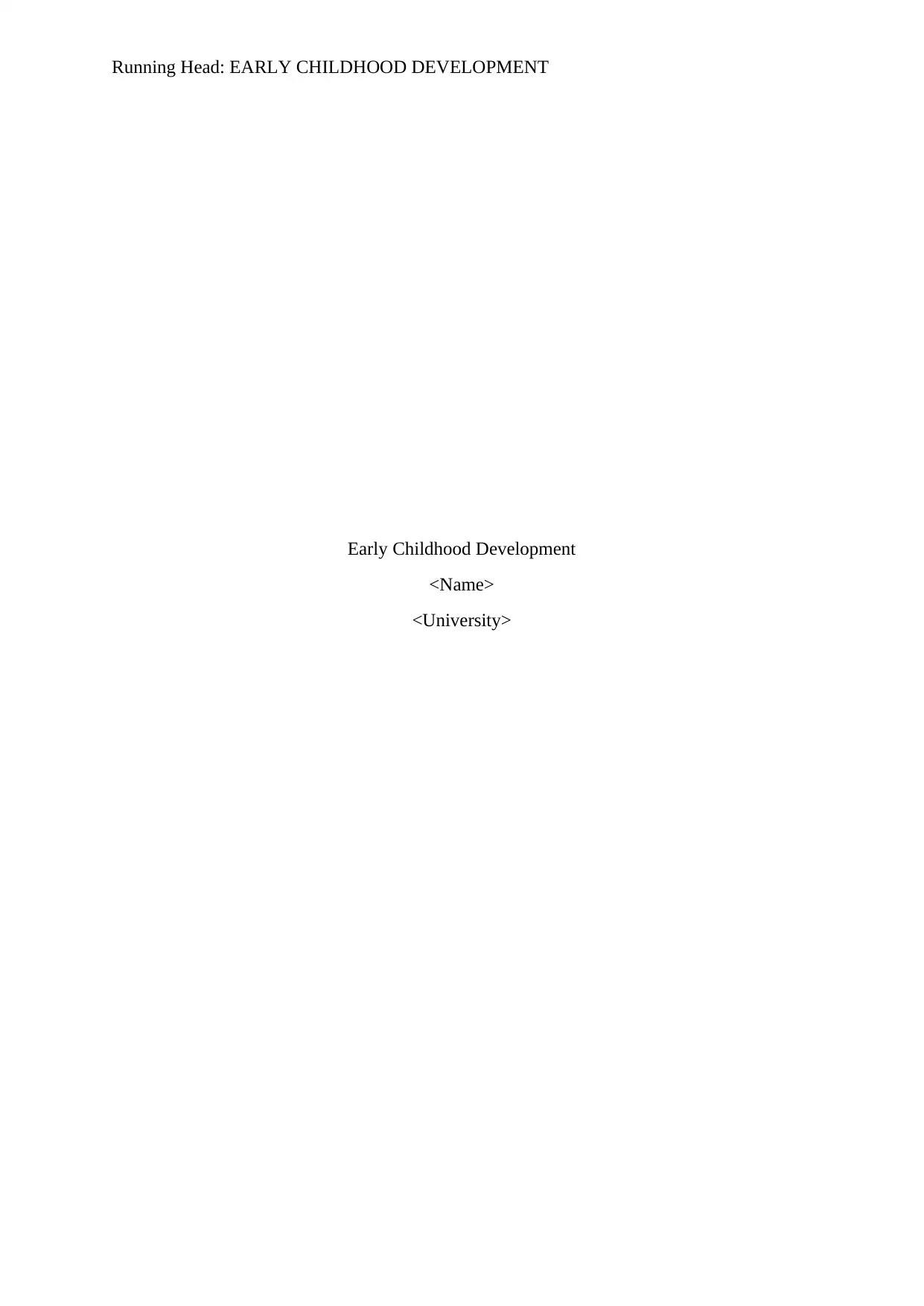
Running Head: EARLY CHILDHOOD DEVELOPMENT
Early Childhood Development
<Name>
<University>
Early Childhood Development
<Name>
<University>
Secure Best Marks with AI Grader
Need help grading? Try our AI Grader for instant feedback on your assignments.
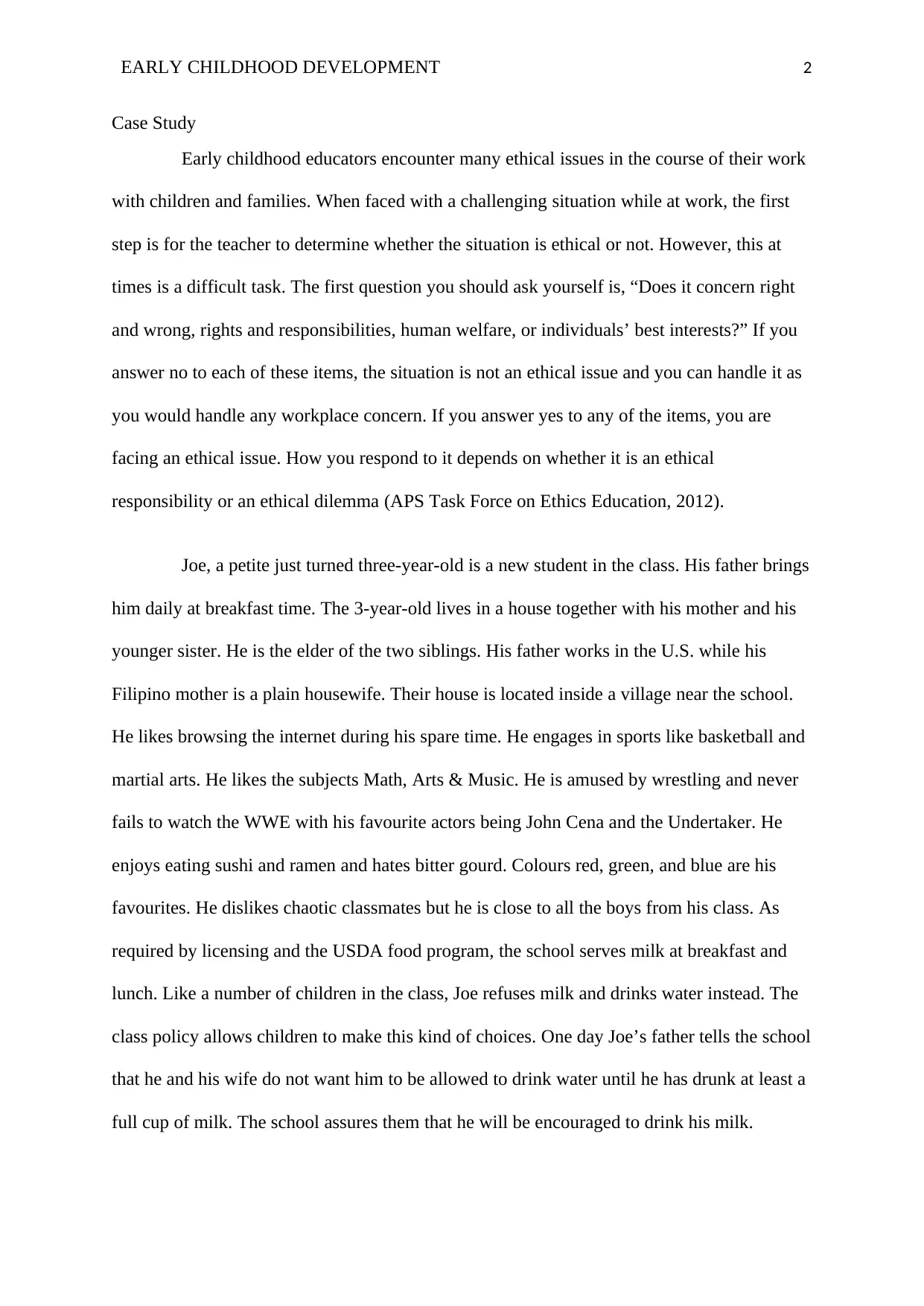
EARLY CHILDHOOD DEVELOPMENT 2
Case Study
Early childhood educators encounter many ethical issues in the course of their work
with children and families. When faced with a challenging situation while at work, the first
step is for the teacher to determine whether the situation is ethical or not. However, this at
times is a difficult task. The first question you should ask yourself is, “Does it concern right
and wrong, rights and responsibilities, human welfare, or individuals’ best interests?” If you
answer no to each of these items, the situation is not an ethical issue and you can handle it as
you would handle any workplace concern. If you answer yes to any of the items, you are
facing an ethical issue. How you respond to it depends on whether it is an ethical
responsibility or an ethical dilemma (APS Task Force on Ethics Education, 2012).
Joe, a petite just turned three-year-old is a new student in the class. His father brings
him daily at breakfast time. The 3-year-old lives in a house together with his mother and his
younger sister. He is the elder of the two siblings. His father works in the U.S. while his
Filipino mother is a plain housewife. Their house is located inside a village near the school.
He likes browsing the internet during his spare time. He engages in sports like basketball and
martial arts. He likes the subjects Math, Arts & Music. He is amused by wrestling and never
fails to watch the WWE with his favourite actors being John Cena and the Undertaker. He
enjoys eating sushi and ramen and hates bitter gourd. Colours red, green, and blue are his
favourites. He dislikes chaotic classmates but he is close to all the boys from his class. As
required by licensing and the USDA food program, the school serves milk at breakfast and
lunch. Like a number of children in the class, Joe refuses milk and drinks water instead. The
class policy allows children to make this kind of choices. One day Joe’s father tells the school
that he and his wife do not want him to be allowed to drink water until he has drunk at least a
full cup of milk. The school assures them that he will be encouraged to drink his milk.
Case Study
Early childhood educators encounter many ethical issues in the course of their work
with children and families. When faced with a challenging situation while at work, the first
step is for the teacher to determine whether the situation is ethical or not. However, this at
times is a difficult task. The first question you should ask yourself is, “Does it concern right
and wrong, rights and responsibilities, human welfare, or individuals’ best interests?” If you
answer no to each of these items, the situation is not an ethical issue and you can handle it as
you would handle any workplace concern. If you answer yes to any of the items, you are
facing an ethical issue. How you respond to it depends on whether it is an ethical
responsibility or an ethical dilemma (APS Task Force on Ethics Education, 2012).
Joe, a petite just turned three-year-old is a new student in the class. His father brings
him daily at breakfast time. The 3-year-old lives in a house together with his mother and his
younger sister. He is the elder of the two siblings. His father works in the U.S. while his
Filipino mother is a plain housewife. Their house is located inside a village near the school.
He likes browsing the internet during his spare time. He engages in sports like basketball and
martial arts. He likes the subjects Math, Arts & Music. He is amused by wrestling and never
fails to watch the WWE with his favourite actors being John Cena and the Undertaker. He
enjoys eating sushi and ramen and hates bitter gourd. Colours red, green, and blue are his
favourites. He dislikes chaotic classmates but he is close to all the boys from his class. As
required by licensing and the USDA food program, the school serves milk at breakfast and
lunch. Like a number of children in the class, Joe refuses milk and drinks water instead. The
class policy allows children to make this kind of choices. One day Joe’s father tells the school
that he and his wife do not want him to be allowed to drink water until he has drunk at least a
full cup of milk. The school assures them that he will be encouraged to drink his milk.
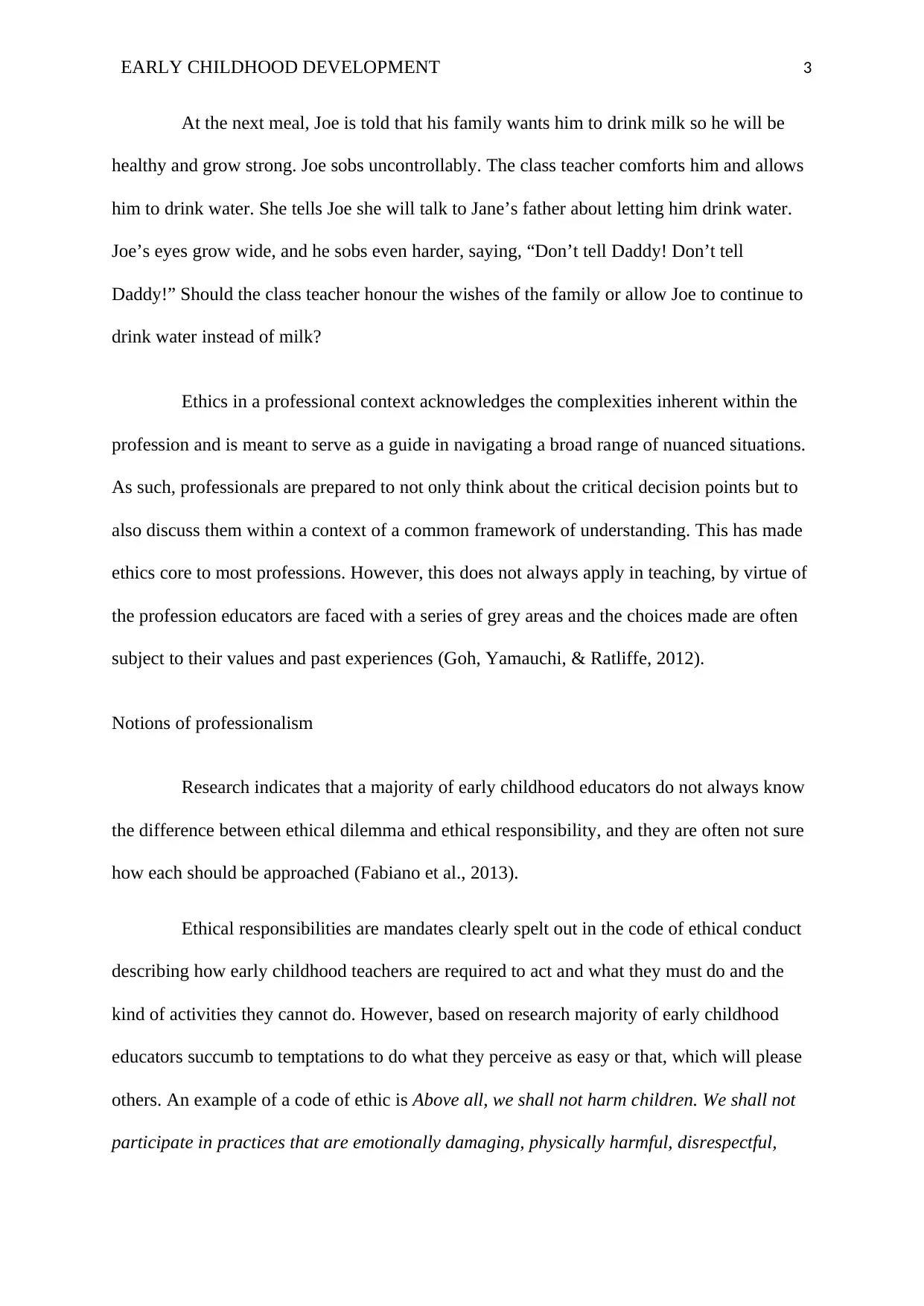
EARLY CHILDHOOD DEVELOPMENT 3
At the next meal, Joe is told that his family wants him to drink milk so he will be
healthy and grow strong. Joe sobs uncontrollably. The class teacher comforts him and allows
him to drink water. She tells Joe she will talk to Jane’s father about letting him drink water.
Joe’s eyes grow wide, and he sobs even harder, saying, “Don’t tell Daddy! Don’t tell
Daddy!” Should the class teacher honour the wishes of the family or allow Joe to continue to
drink water instead of milk?
Ethics in a professional context acknowledges the complexities inherent within the
profession and is meant to serve as a guide in navigating a broad range of nuanced situations.
As such, professionals are prepared to not only think about the critical decision points but to
also discuss them within a context of a common framework of understanding. This has made
ethics core to most professions. However, this does not always apply in teaching, by virtue of
the profession educators are faced with a series of grey areas and the choices made are often
subject to their values and past experiences (Goh, Yamauchi, & Ratliffe, 2012).
Notions of professionalism
Research indicates that a majority of early childhood educators do not always know
the difference between ethical dilemma and ethical responsibility, and they are often not sure
how each should be approached (Fabiano et al., 2013).
Ethical responsibilities are mandates clearly spelt out in the code of ethical conduct
describing how early childhood teachers are required to act and what they must do and the
kind of activities they cannot do. However, based on research majority of early childhood
educators succumb to temptations to do what they perceive as easy or that, which will please
others. An example of a code of ethic is Above all, we shall not harm children. We shall not
participate in practices that are emotionally damaging, physically harmful, disrespectful,
At the next meal, Joe is told that his family wants him to drink milk so he will be
healthy and grow strong. Joe sobs uncontrollably. The class teacher comforts him and allows
him to drink water. She tells Joe she will talk to Jane’s father about letting him drink water.
Joe’s eyes grow wide, and he sobs even harder, saying, “Don’t tell Daddy! Don’t tell
Daddy!” Should the class teacher honour the wishes of the family or allow Joe to continue to
drink water instead of milk?
Ethics in a professional context acknowledges the complexities inherent within the
profession and is meant to serve as a guide in navigating a broad range of nuanced situations.
As such, professionals are prepared to not only think about the critical decision points but to
also discuss them within a context of a common framework of understanding. This has made
ethics core to most professions. However, this does not always apply in teaching, by virtue of
the profession educators are faced with a series of grey areas and the choices made are often
subject to their values and past experiences (Goh, Yamauchi, & Ratliffe, 2012).
Notions of professionalism
Research indicates that a majority of early childhood educators do not always know
the difference between ethical dilemma and ethical responsibility, and they are often not sure
how each should be approached (Fabiano et al., 2013).
Ethical responsibilities are mandates clearly spelt out in the code of ethical conduct
describing how early childhood teachers are required to act and what they must do and the
kind of activities they cannot do. However, based on research majority of early childhood
educators succumb to temptations to do what they perceive as easy or that, which will please
others. An example of a code of ethic is Above all, we shall not harm children. We shall not
participate in practices that are emotionally damaging, physically harmful, disrespectful,
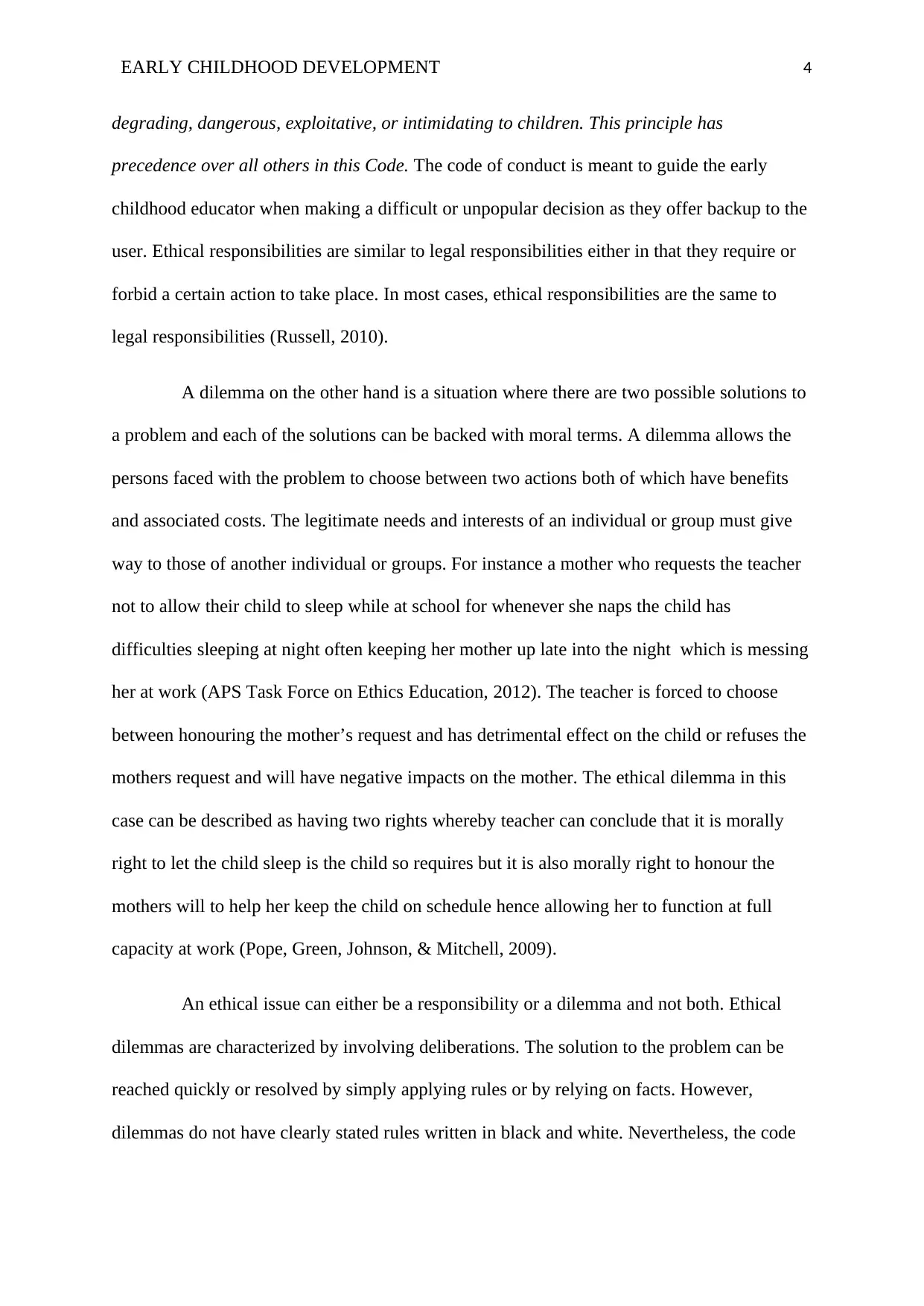
EARLY CHILDHOOD DEVELOPMENT 4
degrading, dangerous, exploitative, or intimidating to children. This principle has
precedence over all others in this Code. The code of conduct is meant to guide the early
childhood educator when making a difficult or unpopular decision as they offer backup to the
user. Ethical responsibilities are similar to legal responsibilities either in that they require or
forbid a certain action to take place. In most cases, ethical responsibilities are the same to
legal responsibilities (Russell, 2010).
A dilemma on the other hand is a situation where there are two possible solutions to
a problem and each of the solutions can be backed with moral terms. A dilemma allows the
persons faced with the problem to choose between two actions both of which have benefits
and associated costs. The legitimate needs and interests of an individual or group must give
way to those of another individual or groups. For instance a mother who requests the teacher
not to allow their child to sleep while at school for whenever she naps the child has
difficulties sleeping at night often keeping her mother up late into the night which is messing
her at work (APS Task Force on Ethics Education, 2012). The teacher is forced to choose
between honouring the mother’s request and has detrimental effect on the child or refuses the
mothers request and will have negative impacts on the mother. The ethical dilemma in this
case can be described as having two rights whereby teacher can conclude that it is morally
right to let the child sleep is the child so requires but it is also morally right to honour the
mothers will to help her keep the child on schedule hence allowing her to function at full
capacity at work (Pope, Green, Johnson, & Mitchell, 2009).
An ethical issue can either be a responsibility or a dilemma and not both. Ethical
dilemmas are characterized by involving deliberations. The solution to the problem can be
reached quickly or resolved by simply applying rules or by relying on facts. However,
dilemmas do not have clearly stated rules written in black and white. Nevertheless, the code
degrading, dangerous, exploitative, or intimidating to children. This principle has
precedence over all others in this Code. The code of conduct is meant to guide the early
childhood educator when making a difficult or unpopular decision as they offer backup to the
user. Ethical responsibilities are similar to legal responsibilities either in that they require or
forbid a certain action to take place. In most cases, ethical responsibilities are the same to
legal responsibilities (Russell, 2010).
A dilemma on the other hand is a situation where there are two possible solutions to
a problem and each of the solutions can be backed with moral terms. A dilemma allows the
persons faced with the problem to choose between two actions both of which have benefits
and associated costs. The legitimate needs and interests of an individual or group must give
way to those of another individual or groups. For instance a mother who requests the teacher
not to allow their child to sleep while at school for whenever she naps the child has
difficulties sleeping at night often keeping her mother up late into the night which is messing
her at work (APS Task Force on Ethics Education, 2012). The teacher is forced to choose
between honouring the mother’s request and has detrimental effect on the child or refuses the
mothers request and will have negative impacts on the mother. The ethical dilemma in this
case can be described as having two rights whereby teacher can conclude that it is morally
right to let the child sleep is the child so requires but it is also morally right to honour the
mothers will to help her keep the child on schedule hence allowing her to function at full
capacity at work (Pope, Green, Johnson, & Mitchell, 2009).
An ethical issue can either be a responsibility or a dilemma and not both. Ethical
dilemmas are characterized by involving deliberations. The solution to the problem can be
reached quickly or resolved by simply applying rules or by relying on facts. However,
dilemmas do not have clearly stated rules written in black and white. Nevertheless, the code
Secure Best Marks with AI Grader
Need help grading? Try our AI Grader for instant feedback on your assignments.
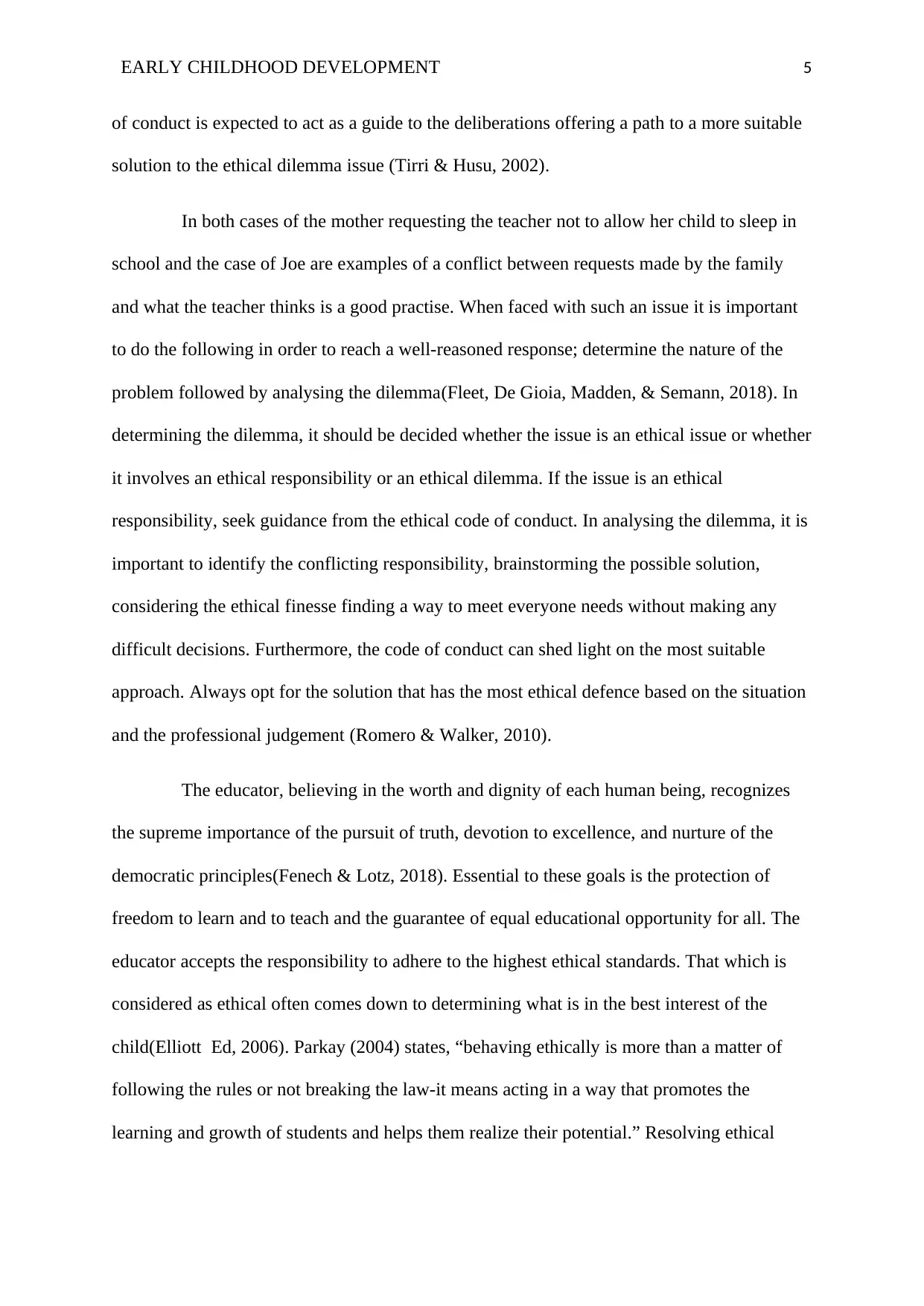
EARLY CHILDHOOD DEVELOPMENT 5
of conduct is expected to act as a guide to the deliberations offering a path to a more suitable
solution to the ethical dilemma issue (Tirri & Husu, 2002).
In both cases of the mother requesting the teacher not to allow her child to sleep in
school and the case of Joe are examples of a conflict between requests made by the family
and what the teacher thinks is a good practise. When faced with such an issue it is important
to do the following in order to reach a well-reasoned response; determine the nature of the
problem followed by analysing the dilemma(Fleet, De Gioia, Madden, & Semann, 2018). In
determining the dilemma, it should be decided whether the issue is an ethical issue or whether
it involves an ethical responsibility or an ethical dilemma. If the issue is an ethical
responsibility, seek guidance from the ethical code of conduct. In analysing the dilemma, it is
important to identify the conflicting responsibility, brainstorming the possible solution,
considering the ethical finesse finding a way to meet everyone needs without making any
difficult decisions. Furthermore, the code of conduct can shed light on the most suitable
approach. Always opt for the solution that has the most ethical defence based on the situation
and the professional judgement (Romero & Walker, 2010).
The educator, believing in the worth and dignity of each human being, recognizes
the supreme importance of the pursuit of truth, devotion to excellence, and nurture of the
democratic principles(Fenech & Lotz, 2018). Essential to these goals is the protection of
freedom to learn and to teach and the guarantee of equal educational opportunity for all. The
educator accepts the responsibility to adhere to the highest ethical standards. That which is
considered as ethical often comes down to determining what is in the best interest of the
child(Elliott Ed, 2006). Parkay (2004) states, “behaving ethically is more than a matter of
following the rules or not breaking the law-it means acting in a way that promotes the
learning and growth of students and helps them realize their potential.” Resolving ethical
of conduct is expected to act as a guide to the deliberations offering a path to a more suitable
solution to the ethical dilemma issue (Tirri & Husu, 2002).
In both cases of the mother requesting the teacher not to allow her child to sleep in
school and the case of Joe are examples of a conflict between requests made by the family
and what the teacher thinks is a good practise. When faced with such an issue it is important
to do the following in order to reach a well-reasoned response; determine the nature of the
problem followed by analysing the dilemma(Fleet, De Gioia, Madden, & Semann, 2018). In
determining the dilemma, it should be decided whether the issue is an ethical issue or whether
it involves an ethical responsibility or an ethical dilemma. If the issue is an ethical
responsibility, seek guidance from the ethical code of conduct. In analysing the dilemma, it is
important to identify the conflicting responsibility, brainstorming the possible solution,
considering the ethical finesse finding a way to meet everyone needs without making any
difficult decisions. Furthermore, the code of conduct can shed light on the most suitable
approach. Always opt for the solution that has the most ethical defence based on the situation
and the professional judgement (Romero & Walker, 2010).
The educator, believing in the worth and dignity of each human being, recognizes
the supreme importance of the pursuit of truth, devotion to excellence, and nurture of the
democratic principles(Fenech & Lotz, 2018). Essential to these goals is the protection of
freedom to learn and to teach and the guarantee of equal educational opportunity for all. The
educator accepts the responsibility to adhere to the highest ethical standards. That which is
considered as ethical often comes down to determining what is in the best interest of the
child(Elliott Ed, 2006). Parkay (2004) states, “behaving ethically is more than a matter of
following the rules or not breaking the law-it means acting in a way that promotes the
learning and growth of students and helps them realize their potential.” Resolving ethical
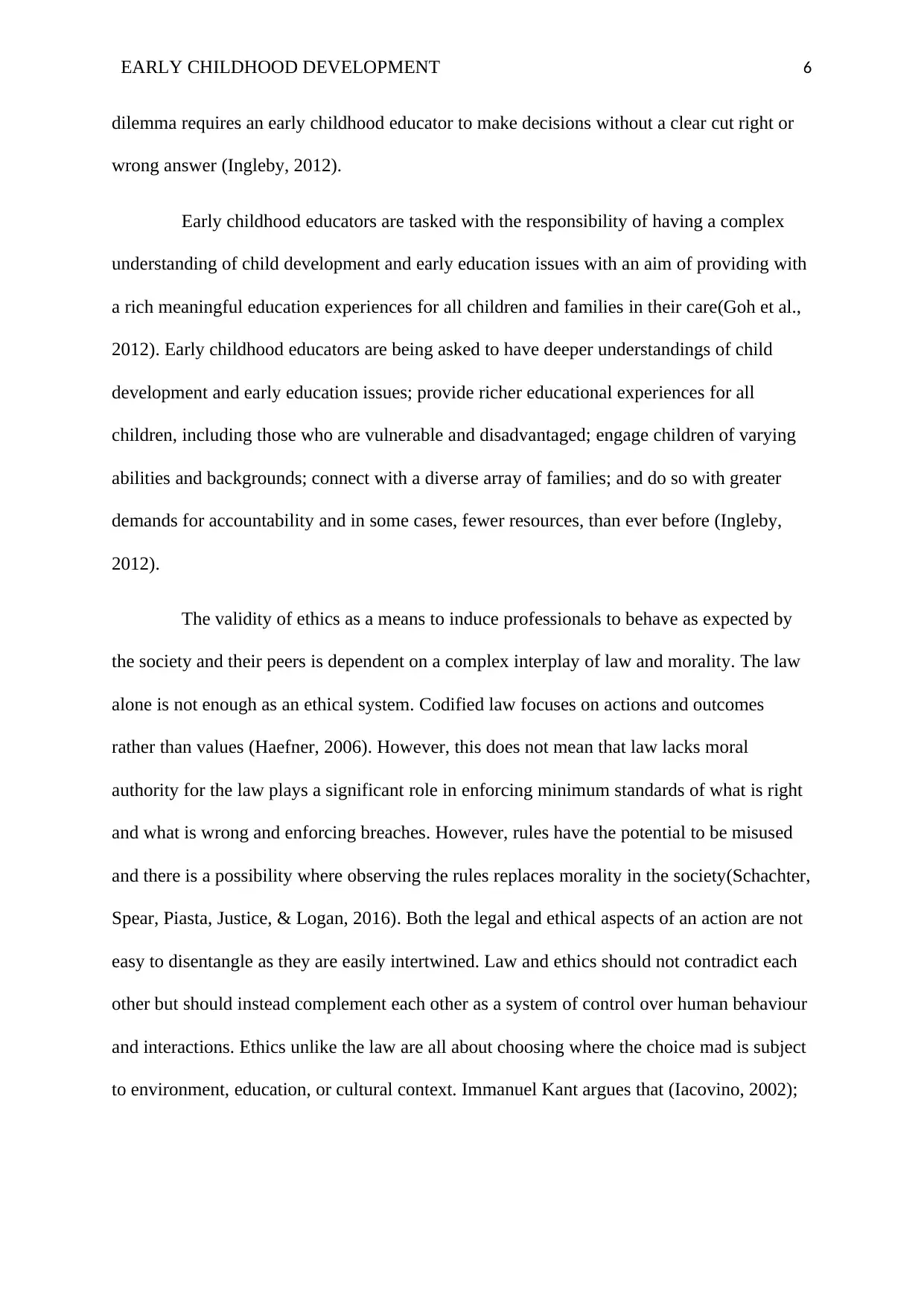
EARLY CHILDHOOD DEVELOPMENT 6
dilemma requires an early childhood educator to make decisions without a clear cut right or
wrong answer (Ingleby, 2012).
Early childhood educators are tasked with the responsibility of having a complex
understanding of child development and early education issues with an aim of providing with
a rich meaningful education experiences for all children and families in their care(Goh et al.,
2012). Early childhood educators are being asked to have deeper understandings of child
development and early education issues; provide richer educational experiences for all
children, including those who are vulnerable and disadvantaged; engage children of varying
abilities and backgrounds; connect with a diverse array of families; and do so with greater
demands for accountability and in some cases, fewer resources, than ever before (Ingleby,
2012).
The validity of ethics as a means to induce professionals to behave as expected by
the society and their peers is dependent on a complex interplay of law and morality. The law
alone is not enough as an ethical system. Codified law focuses on actions and outcomes
rather than values (Haefner, 2006). However, this does not mean that law lacks moral
authority for the law plays a significant role in enforcing minimum standards of what is right
and what is wrong and enforcing breaches. However, rules have the potential to be misused
and there is a possibility where observing the rules replaces morality in the society(Schachter,
Spear, Piasta, Justice, & Logan, 2016). Both the legal and ethical aspects of an action are not
easy to disentangle as they are easily intertwined. Law and ethics should not contradict each
other but should instead complement each other as a system of control over human behaviour
and interactions. Ethics unlike the law are all about choosing where the choice mad is subject
to environment, education, or cultural context. Immanuel Kant argues that (Iacovino, 2002);
dilemma requires an early childhood educator to make decisions without a clear cut right or
wrong answer (Ingleby, 2012).
Early childhood educators are tasked with the responsibility of having a complex
understanding of child development and early education issues with an aim of providing with
a rich meaningful education experiences for all children and families in their care(Goh et al.,
2012). Early childhood educators are being asked to have deeper understandings of child
development and early education issues; provide richer educational experiences for all
children, including those who are vulnerable and disadvantaged; engage children of varying
abilities and backgrounds; connect with a diverse array of families; and do so with greater
demands for accountability and in some cases, fewer resources, than ever before (Ingleby,
2012).
The validity of ethics as a means to induce professionals to behave as expected by
the society and their peers is dependent on a complex interplay of law and morality. The law
alone is not enough as an ethical system. Codified law focuses on actions and outcomes
rather than values (Haefner, 2006). However, this does not mean that law lacks moral
authority for the law plays a significant role in enforcing minimum standards of what is right
and what is wrong and enforcing breaches. However, rules have the potential to be misused
and there is a possibility where observing the rules replaces morality in the society(Schachter,
Spear, Piasta, Justice, & Logan, 2016). Both the legal and ethical aspects of an action are not
easy to disentangle as they are easily intertwined. Law and ethics should not contradict each
other but should instead complement each other as a system of control over human behaviour
and interactions. Ethics unlike the law are all about choosing where the choice mad is subject
to environment, education, or cultural context. Immanuel Kant argues that (Iacovino, 2002);
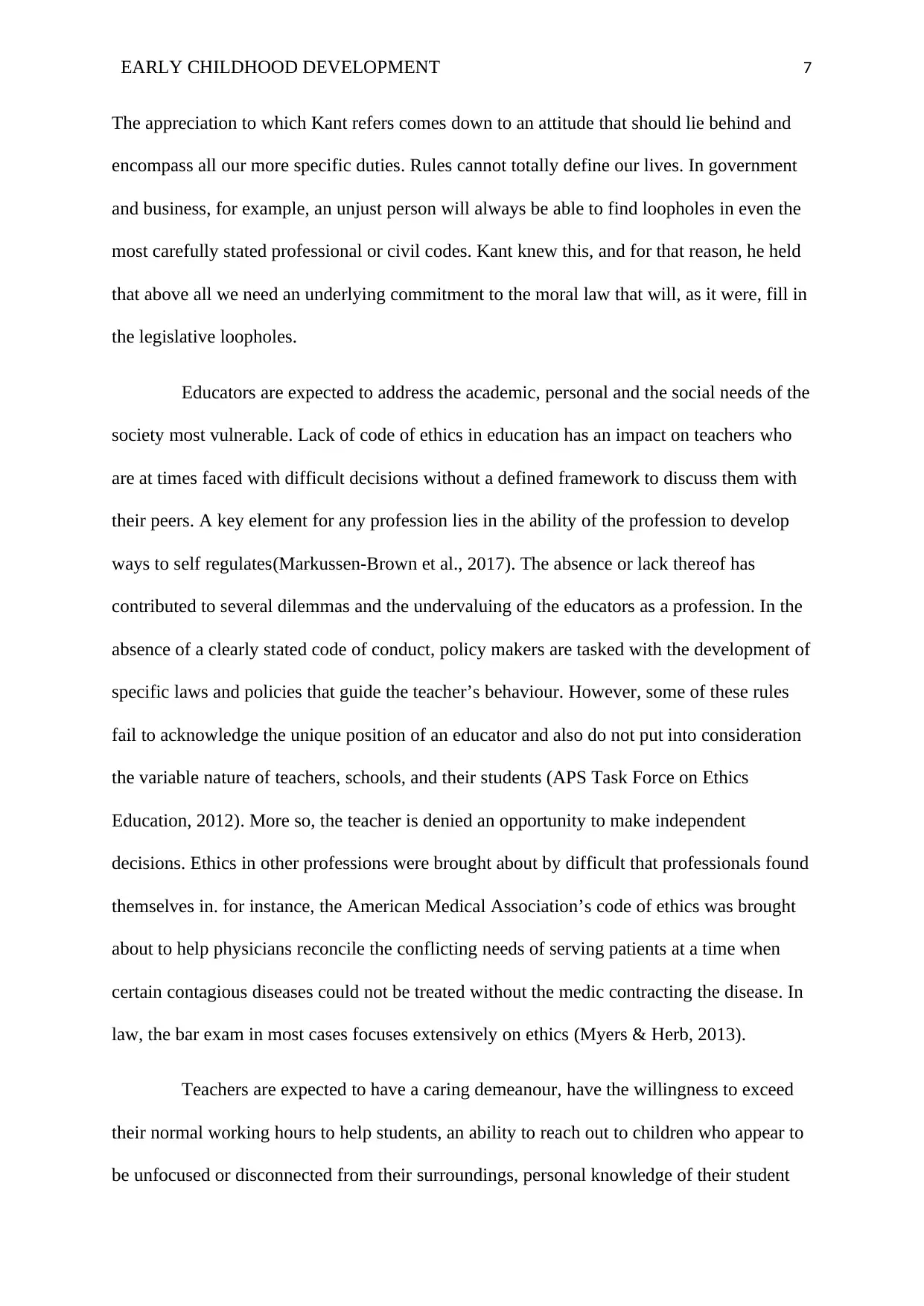
EARLY CHILDHOOD DEVELOPMENT 7
The appreciation to which Kant refers comes down to an attitude that should lie behind and
encompass all our more specific duties. Rules cannot totally define our lives. In government
and business, for example, an unjust person will always be able to find loopholes in even the
most carefully stated professional or civil codes. Kant knew this, and for that reason, he held
that above all we need an underlying commitment to the moral law that will, as it were, fill in
the legislative loopholes.
Educators are expected to address the academic, personal and the social needs of the
society most vulnerable. Lack of code of ethics in education has an impact on teachers who
are at times faced with difficult decisions without a defined framework to discuss them with
their peers. A key element for any profession lies in the ability of the profession to develop
ways to self regulates(Markussen-Brown et al., 2017). The absence or lack thereof has
contributed to several dilemmas and the undervaluing of the educators as a profession. In the
absence of a clearly stated code of conduct, policy makers are tasked with the development of
specific laws and policies that guide the teacher’s behaviour. However, some of these rules
fail to acknowledge the unique position of an educator and also do not put into consideration
the variable nature of teachers, schools, and their students (APS Task Force on Ethics
Education, 2012). More so, the teacher is denied an opportunity to make independent
decisions. Ethics in other professions were brought about by difficult that professionals found
themselves in. for instance, the American Medical Association’s code of ethics was brought
about to help physicians reconcile the conflicting needs of serving patients at a time when
certain contagious diseases could not be treated without the medic contracting the disease. In
law, the bar exam in most cases focuses extensively on ethics (Myers & Herb, 2013).
Teachers are expected to have a caring demeanour, have the willingness to exceed
their normal working hours to help students, an ability to reach out to children who appear to
be unfocused or disconnected from their surroundings, personal knowledge of their student
The appreciation to which Kant refers comes down to an attitude that should lie behind and
encompass all our more specific duties. Rules cannot totally define our lives. In government
and business, for example, an unjust person will always be able to find loopholes in even the
most carefully stated professional or civil codes. Kant knew this, and for that reason, he held
that above all we need an underlying commitment to the moral law that will, as it were, fill in
the legislative loopholes.
Educators are expected to address the academic, personal and the social needs of the
society most vulnerable. Lack of code of ethics in education has an impact on teachers who
are at times faced with difficult decisions without a defined framework to discuss them with
their peers. A key element for any profession lies in the ability of the profession to develop
ways to self regulates(Markussen-Brown et al., 2017). The absence or lack thereof has
contributed to several dilemmas and the undervaluing of the educators as a profession. In the
absence of a clearly stated code of conduct, policy makers are tasked with the development of
specific laws and policies that guide the teacher’s behaviour. However, some of these rules
fail to acknowledge the unique position of an educator and also do not put into consideration
the variable nature of teachers, schools, and their students (APS Task Force on Ethics
Education, 2012). More so, the teacher is denied an opportunity to make independent
decisions. Ethics in other professions were brought about by difficult that professionals found
themselves in. for instance, the American Medical Association’s code of ethics was brought
about to help physicians reconcile the conflicting needs of serving patients at a time when
certain contagious diseases could not be treated without the medic contracting the disease. In
law, the bar exam in most cases focuses extensively on ethics (Myers & Herb, 2013).
Teachers are expected to have a caring demeanour, have the willingness to exceed
their normal working hours to help students, an ability to reach out to children who appear to
be unfocused or disconnected from their surroundings, personal knowledge of their student
Paraphrase This Document
Need a fresh take? Get an instant paraphrase of this document with our AI Paraphraser
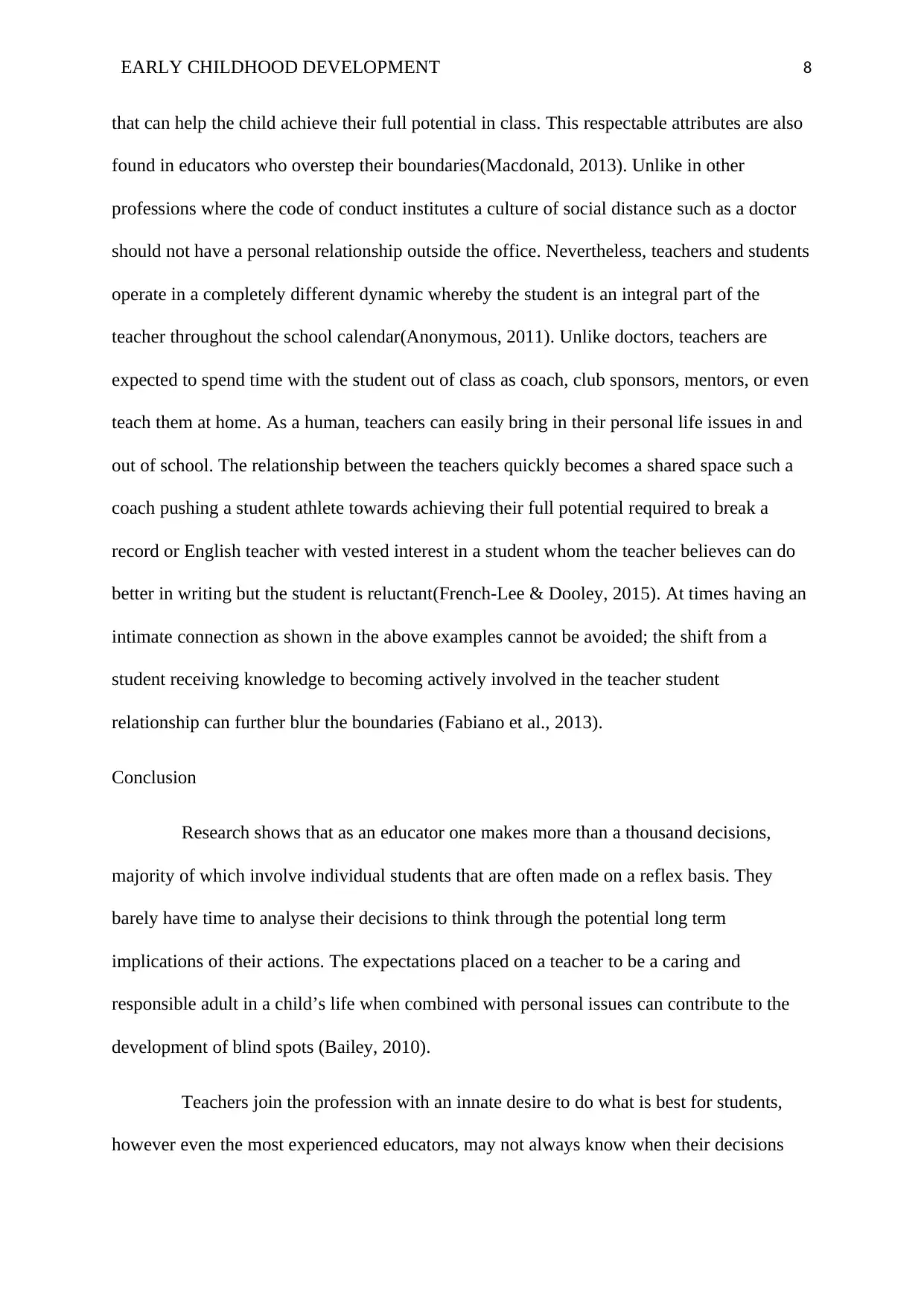
EARLY CHILDHOOD DEVELOPMENT 8
that can help the child achieve their full potential in class. This respectable attributes are also
found in educators who overstep their boundaries(Macdonald, 2013). Unlike in other
professions where the code of conduct institutes a culture of social distance such as a doctor
should not have a personal relationship outside the office. Nevertheless, teachers and students
operate in a completely different dynamic whereby the student is an integral part of the
teacher throughout the school calendar(Anonymous, 2011). Unlike doctors, teachers are
expected to spend time with the student out of class as coach, club sponsors, mentors, or even
teach them at home. As a human, teachers can easily bring in their personal life issues in and
out of school. The relationship between the teachers quickly becomes a shared space such a
coach pushing a student athlete towards achieving their full potential required to break a
record or English teacher with vested interest in a student whom the teacher believes can do
better in writing but the student is reluctant(French-Lee & Dooley, 2015). At times having an
intimate connection as shown in the above examples cannot be avoided; the shift from a
student receiving knowledge to becoming actively involved in the teacher student
relationship can further blur the boundaries (Fabiano et al., 2013).
Conclusion
Research shows that as an educator one makes more than a thousand decisions,
majority of which involve individual students that are often made on a reflex basis. They
barely have time to analyse their decisions to think through the potential long term
implications of their actions. The expectations placed on a teacher to be a caring and
responsible adult in a child’s life when combined with personal issues can contribute to the
development of blind spots (Bailey, 2010).
Teachers join the profession with an innate desire to do what is best for students,
however even the most experienced educators, may not always know when their decisions
that can help the child achieve their full potential in class. This respectable attributes are also
found in educators who overstep their boundaries(Macdonald, 2013). Unlike in other
professions where the code of conduct institutes a culture of social distance such as a doctor
should not have a personal relationship outside the office. Nevertheless, teachers and students
operate in a completely different dynamic whereby the student is an integral part of the
teacher throughout the school calendar(Anonymous, 2011). Unlike doctors, teachers are
expected to spend time with the student out of class as coach, club sponsors, mentors, or even
teach them at home. As a human, teachers can easily bring in their personal life issues in and
out of school. The relationship between the teachers quickly becomes a shared space such a
coach pushing a student athlete towards achieving their full potential required to break a
record or English teacher with vested interest in a student whom the teacher believes can do
better in writing but the student is reluctant(French-Lee & Dooley, 2015). At times having an
intimate connection as shown in the above examples cannot be avoided; the shift from a
student receiving knowledge to becoming actively involved in the teacher student
relationship can further blur the boundaries (Fabiano et al., 2013).
Conclusion
Research shows that as an educator one makes more than a thousand decisions,
majority of which involve individual students that are often made on a reflex basis. They
barely have time to analyse their decisions to think through the potential long term
implications of their actions. The expectations placed on a teacher to be a caring and
responsible adult in a child’s life when combined with personal issues can contribute to the
development of blind spots (Bailey, 2010).
Teachers join the profession with an innate desire to do what is best for students,
however even the most experienced educators, may not always know when their decisions
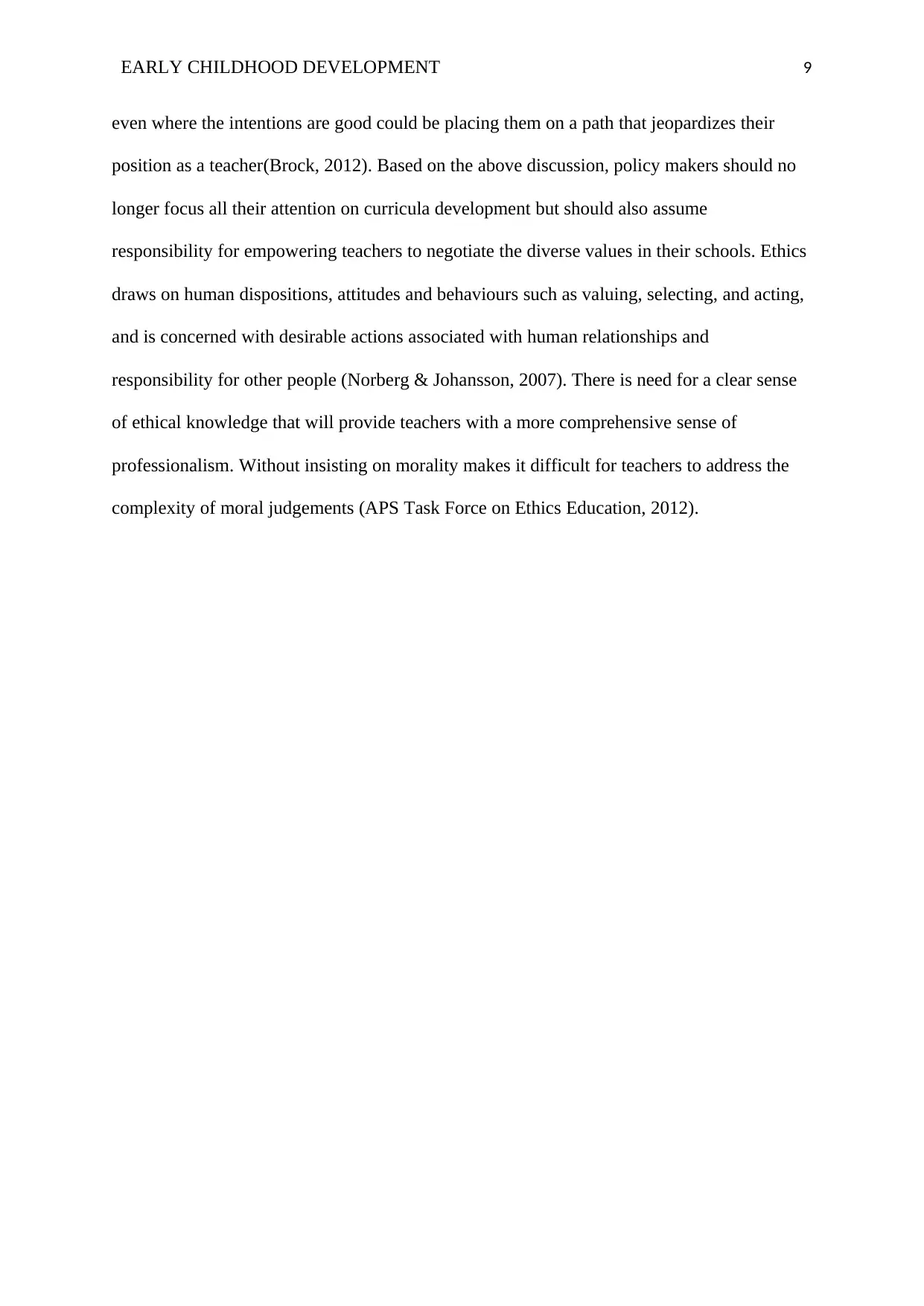
EARLY CHILDHOOD DEVELOPMENT 9
even where the intentions are good could be placing them on a path that jeopardizes their
position as a teacher(Brock, 2012). Based on the above discussion, policy makers should no
longer focus all their attention on curricula development but should also assume
responsibility for empowering teachers to negotiate the diverse values in their schools. Ethics
draws on human dispositions, attitudes and behaviours such as valuing, selecting, and acting,
and is concerned with desirable actions associated with human relationships and
responsibility for other people (Norberg & Johansson, 2007). There is need for a clear sense
of ethical knowledge that will provide teachers with a more comprehensive sense of
professionalism. Without insisting on morality makes it difficult for teachers to address the
complexity of moral judgements (APS Task Force on Ethics Education, 2012).
even where the intentions are good could be placing them on a path that jeopardizes their
position as a teacher(Brock, 2012). Based on the above discussion, policy makers should no
longer focus all their attention on curricula development but should also assume
responsibility for empowering teachers to negotiate the diverse values in their schools. Ethics
draws on human dispositions, attitudes and behaviours such as valuing, selecting, and acting,
and is concerned with desirable actions associated with human relationships and
responsibility for other people (Norberg & Johansson, 2007). There is need for a clear sense
of ethical knowledge that will provide teachers with a more comprehensive sense of
professionalism. Without insisting on morality makes it difficult for teachers to address the
complexity of moral judgements (APS Task Force on Ethics Education, 2012).
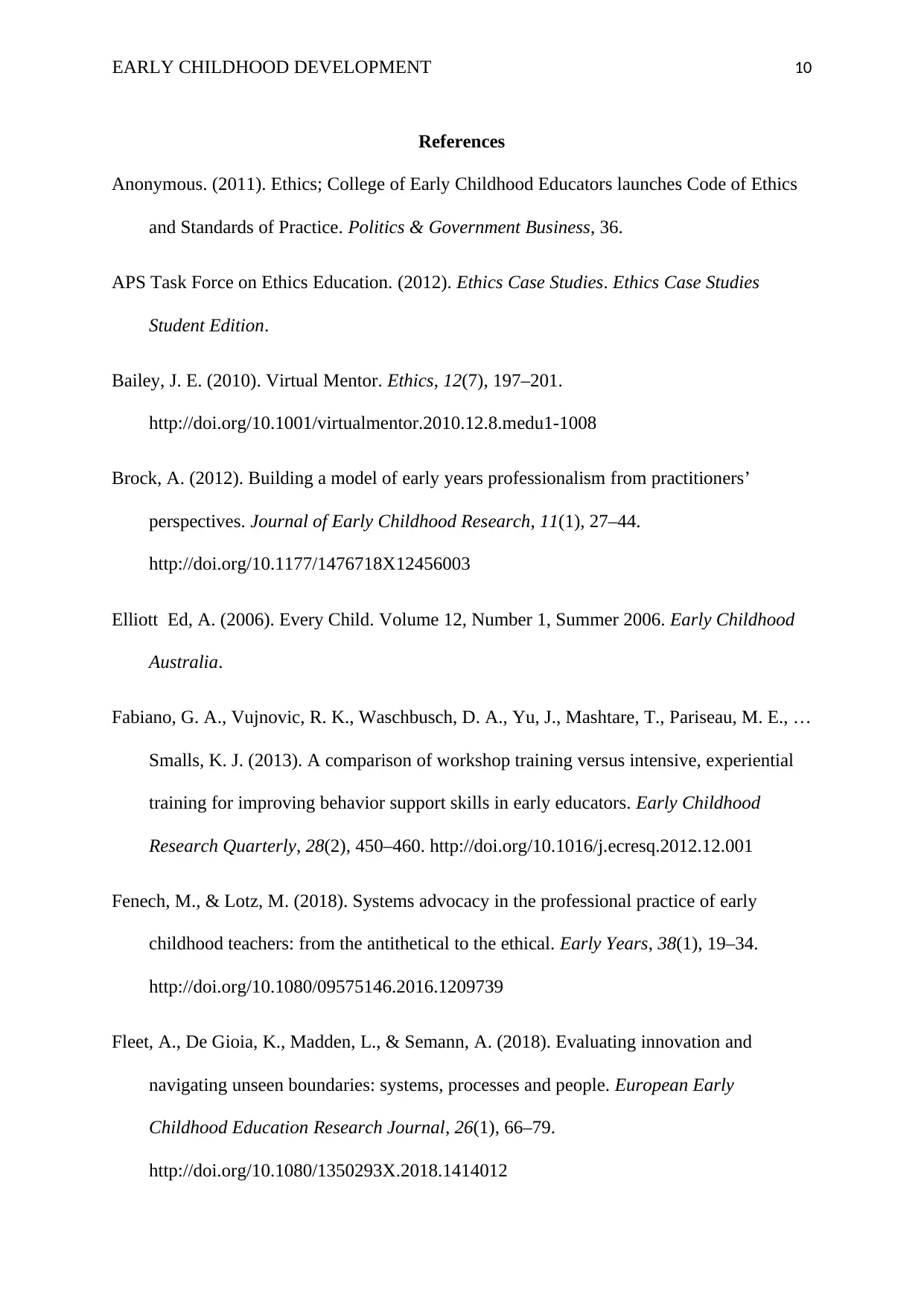
EARLY CHILDHOOD DEVELOPMENT 10
References
Anonymous. (2011). Ethics; College of Early Childhood Educators launches Code of Ethics
and Standards of Practice. Politics & Government Business, 36.
APS Task Force on Ethics Education. (2012). Ethics Case Studies. Ethics Case Studies
Student Edition.
Bailey, J. E. (2010). Virtual Mentor. Ethics, 12(7), 197–201.
http://doi.org/10.1001/virtualmentor.2010.12.8.medu1-1008
Brock, A. (2012). Building a model of early years professionalism from practitioners’
perspectives. Journal of Early Childhood Research, 11(1), 27–44.
http://doi.org/10.1177/1476718X12456003
Elliott Ed, A. (2006). Every Child. Volume 12, Number 1, Summer 2006. Early Childhood
Australia.
Fabiano, G. A., Vujnovic, R. K., Waschbusch, D. A., Yu, J., Mashtare, T., Pariseau, M. E., …
Smalls, K. J. (2013). A comparison of workshop training versus intensive, experiential
training for improving behavior support skills in early educators. Early Childhood
Research Quarterly, 28(2), 450–460. http://doi.org/10.1016/j.ecresq.2012.12.001
Fenech, M., & Lotz, M. (2018). Systems advocacy in the professional practice of early
childhood teachers: from the antithetical to the ethical. Early Years, 38(1), 19–34.
http://doi.org/10.1080/09575146.2016.1209739
Fleet, A., De Gioia, K., Madden, L., & Semann, A. (2018). Evaluating innovation and
navigating unseen boundaries: systems, processes and people. European Early
Childhood Education Research Journal, 26(1), 66–79.
http://doi.org/10.1080/1350293X.2018.1414012
References
Anonymous. (2011). Ethics; College of Early Childhood Educators launches Code of Ethics
and Standards of Practice. Politics & Government Business, 36.
APS Task Force on Ethics Education. (2012). Ethics Case Studies. Ethics Case Studies
Student Edition.
Bailey, J. E. (2010). Virtual Mentor. Ethics, 12(7), 197–201.
http://doi.org/10.1001/virtualmentor.2010.12.8.medu1-1008
Brock, A. (2012). Building a model of early years professionalism from practitioners’
perspectives. Journal of Early Childhood Research, 11(1), 27–44.
http://doi.org/10.1177/1476718X12456003
Elliott Ed, A. (2006). Every Child. Volume 12, Number 1, Summer 2006. Early Childhood
Australia.
Fabiano, G. A., Vujnovic, R. K., Waschbusch, D. A., Yu, J., Mashtare, T., Pariseau, M. E., …
Smalls, K. J. (2013). A comparison of workshop training versus intensive, experiential
training for improving behavior support skills in early educators. Early Childhood
Research Quarterly, 28(2), 450–460. http://doi.org/10.1016/j.ecresq.2012.12.001
Fenech, M., & Lotz, M. (2018). Systems advocacy in the professional practice of early
childhood teachers: from the antithetical to the ethical. Early Years, 38(1), 19–34.
http://doi.org/10.1080/09575146.2016.1209739
Fleet, A., De Gioia, K., Madden, L., & Semann, A. (2018). Evaluating innovation and
navigating unseen boundaries: systems, processes and people. European Early
Childhood Education Research Journal, 26(1), 66–79.
http://doi.org/10.1080/1350293X.2018.1414012
Secure Best Marks with AI Grader
Need help grading? Try our AI Grader for instant feedback on your assignments.
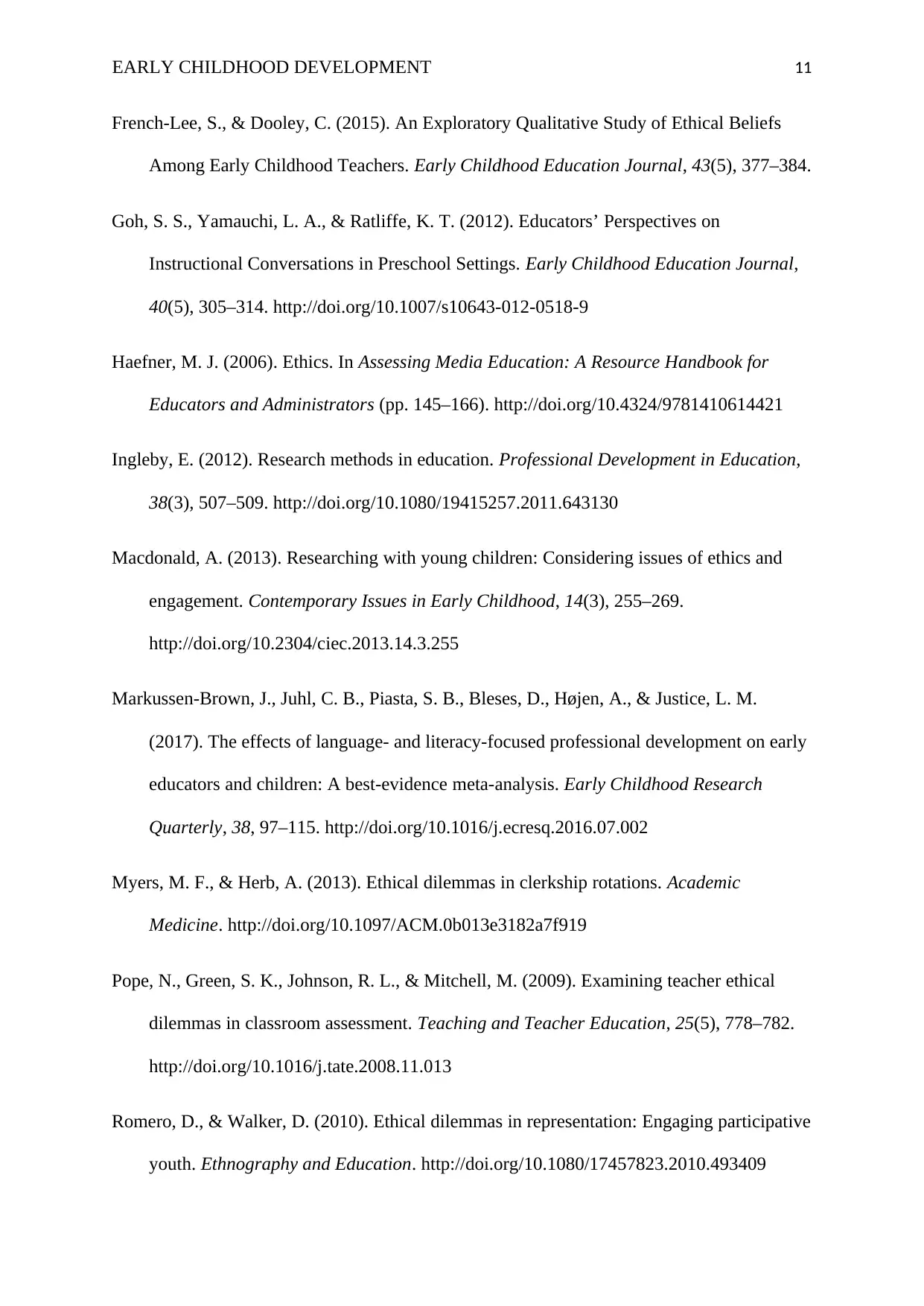
EARLY CHILDHOOD DEVELOPMENT 11
French-Lee, S., & Dooley, C. (2015). An Exploratory Qualitative Study of Ethical Beliefs
Among Early Childhood Teachers. Early Childhood Education Journal, 43(5), 377–384.
Goh, S. S., Yamauchi, L. A., & Ratliffe, K. T. (2012). Educators’ Perspectives on
Instructional Conversations in Preschool Settings. Early Childhood Education Journal,
40(5), 305–314. http://doi.org/10.1007/s10643-012-0518-9
Haefner, M. J. (2006). Ethics. In Assessing Media Education: A Resource Handbook for
Educators and Administrators (pp. 145–166). http://doi.org/10.4324/9781410614421
Ingleby, E. (2012). Research methods in education. Professional Development in Education,
38(3), 507–509. http://doi.org/10.1080/19415257.2011.643130
Macdonald, A. (2013). Researching with young children: Considering issues of ethics and
engagement. Contemporary Issues in Early Childhood, 14(3), 255–269.
http://doi.org/10.2304/ciec.2013.14.3.255
Markussen-Brown, J., Juhl, C. B., Piasta, S. B., Bleses, D., Højen, A., & Justice, L. M.
(2017). The effects of language- and literacy-focused professional development on early
educators and children: A best-evidence meta-analysis. Early Childhood Research
Quarterly, 38, 97–115. http://doi.org/10.1016/j.ecresq.2016.07.002
Myers, M. F., & Herb, A. (2013). Ethical dilemmas in clerkship rotations. Academic
Medicine. http://doi.org/10.1097/ACM.0b013e3182a7f919
Pope, N., Green, S. K., Johnson, R. L., & Mitchell, M. (2009). Examining teacher ethical
dilemmas in classroom assessment. Teaching and Teacher Education, 25(5), 778–782.
http://doi.org/10.1016/j.tate.2008.11.013
Romero, D., & Walker, D. (2010). Ethical dilemmas in representation: Engaging participative
youth. Ethnography and Education. http://doi.org/10.1080/17457823.2010.493409
French-Lee, S., & Dooley, C. (2015). An Exploratory Qualitative Study of Ethical Beliefs
Among Early Childhood Teachers. Early Childhood Education Journal, 43(5), 377–384.
Goh, S. S., Yamauchi, L. A., & Ratliffe, K. T. (2012). Educators’ Perspectives on
Instructional Conversations in Preschool Settings. Early Childhood Education Journal,
40(5), 305–314. http://doi.org/10.1007/s10643-012-0518-9
Haefner, M. J. (2006). Ethics. In Assessing Media Education: A Resource Handbook for
Educators and Administrators (pp. 145–166). http://doi.org/10.4324/9781410614421
Ingleby, E. (2012). Research methods in education. Professional Development in Education,
38(3), 507–509. http://doi.org/10.1080/19415257.2011.643130
Macdonald, A. (2013). Researching with young children: Considering issues of ethics and
engagement. Contemporary Issues in Early Childhood, 14(3), 255–269.
http://doi.org/10.2304/ciec.2013.14.3.255
Markussen-Brown, J., Juhl, C. B., Piasta, S. B., Bleses, D., Højen, A., & Justice, L. M.
(2017). The effects of language- and literacy-focused professional development on early
educators and children: A best-evidence meta-analysis. Early Childhood Research
Quarterly, 38, 97–115. http://doi.org/10.1016/j.ecresq.2016.07.002
Myers, M. F., & Herb, A. (2013). Ethical dilemmas in clerkship rotations. Academic
Medicine. http://doi.org/10.1097/ACM.0b013e3182a7f919
Pope, N., Green, S. K., Johnson, R. L., & Mitchell, M. (2009). Examining teacher ethical
dilemmas in classroom assessment. Teaching and Teacher Education, 25(5), 778–782.
http://doi.org/10.1016/j.tate.2008.11.013
Romero, D., & Walker, D. (2010). Ethical dilemmas in representation: Engaging participative
youth. Ethnography and Education. http://doi.org/10.1080/17457823.2010.493409
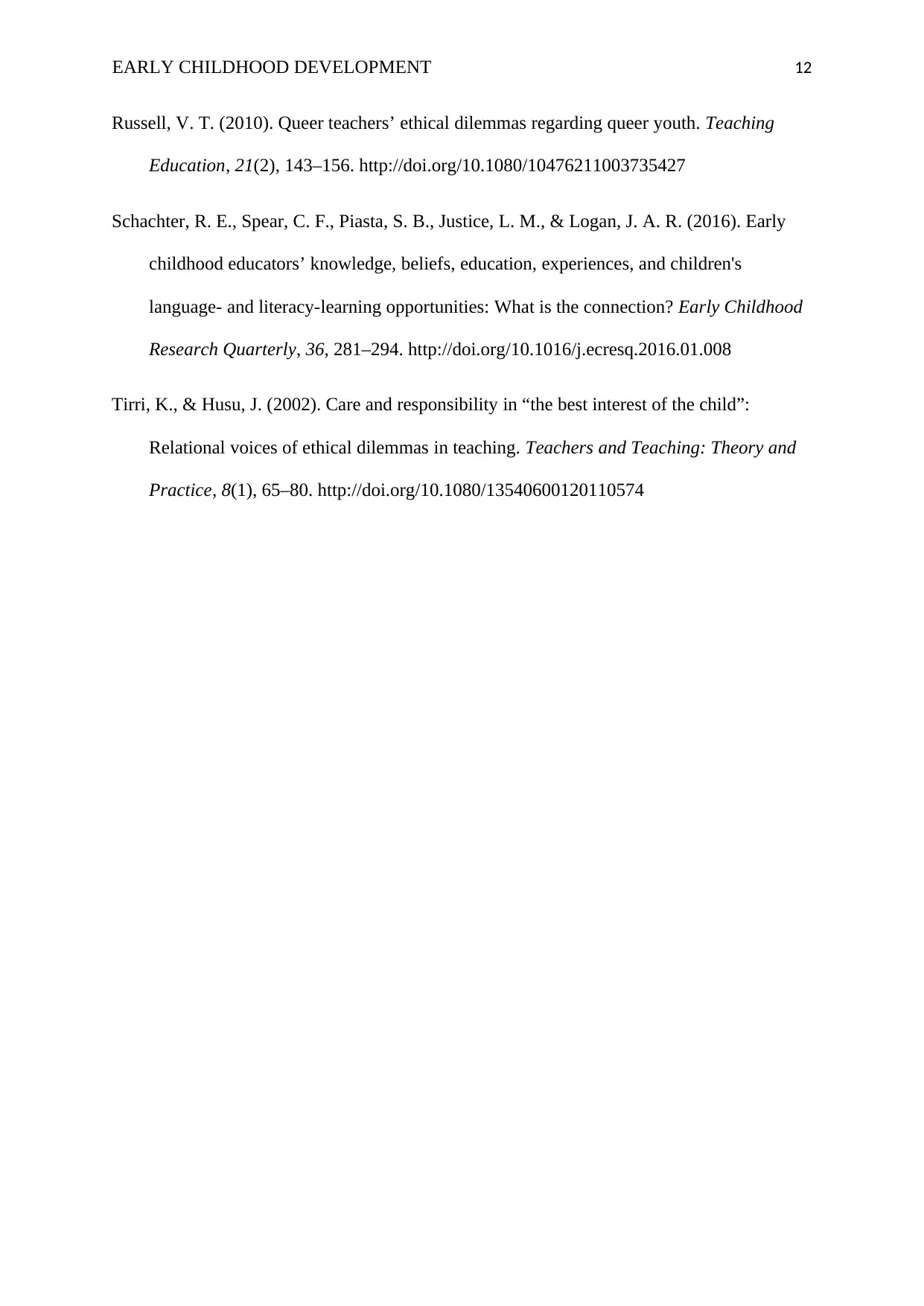
EARLY CHILDHOOD DEVELOPMENT 12
Russell, V. T. (2010). Queer teachers’ ethical dilemmas regarding queer youth. Teaching
Education, 21(2), 143–156. http://doi.org/10.1080/10476211003735427
Schachter, R. E., Spear, C. F., Piasta, S. B., Justice, L. M., & Logan, J. A. R. (2016). Early
childhood educators’ knowledge, beliefs, education, experiences, and children's
language- and literacy-learning opportunities: What is the connection? Early Childhood
Research Quarterly, 36, 281–294. http://doi.org/10.1016/j.ecresq.2016.01.008
Tirri, K., & Husu, J. (2002). Care and responsibility in “the best interest of the child”:
Relational voices of ethical dilemmas in teaching. Teachers and Teaching: Theory and
Practice, 8(1), 65–80. http://doi.org/10.1080/13540600120110574
Russell, V. T. (2010). Queer teachers’ ethical dilemmas regarding queer youth. Teaching
Education, 21(2), 143–156. http://doi.org/10.1080/10476211003735427
Schachter, R. E., Spear, C. F., Piasta, S. B., Justice, L. M., & Logan, J. A. R. (2016). Early
childhood educators’ knowledge, beliefs, education, experiences, and children's
language- and literacy-learning opportunities: What is the connection? Early Childhood
Research Quarterly, 36, 281–294. http://doi.org/10.1016/j.ecresq.2016.01.008
Tirri, K., & Husu, J. (2002). Care and responsibility in “the best interest of the child”:
Relational voices of ethical dilemmas in teaching. Teachers and Teaching: Theory and
Practice, 8(1), 65–80. http://doi.org/10.1080/13540600120110574
1 out of 12
Related Documents
Your All-in-One AI-Powered Toolkit for Academic Success.
+13062052269
info@desklib.com
Available 24*7 on WhatsApp / Email
![[object Object]](/_next/static/media/star-bottom.7253800d.svg)
Unlock your academic potential
© 2024 | Zucol Services PVT LTD | All rights reserved.



